Geek Out 1000 by LH Labs
The USB dongle or thumb drive form factor for DACs has become not quite common, but certainly not a surprise. A half dozen vendors come to mind but, by and large, they are baseline devices, with only the Cambridge Audio DacMagic XS and Meridian’s Explorer2 natively supporting 4x or 176.4 and 192 kHz sampling rates. With the fairly rapid appearance of single and multi–rate DSD consumables in the downloads marketplace, along with 8x DXD files, many consumers desire a more future–proof purchase. Resonnessence Labs has their more modern, $350 HERUS and $425 HERUS+ that support the new formats, but my head has been turned by another small, slender thing…
They may be a bit goofy and some might say slightly unhinged, but one thing the folks at Light Harmonic are not is conservative. To design something better than what was available back in 2012, iconoclast Larry Ho and his band of merry technogeeks decided to go farther, to get…weird. The result; their Geek Out series of USB DACs on KickStarter, one of several crowd–funded projects they launched (although subsequent campaigns ran on IndieGogo). Some 16 products are currently in development, with several variations in the mix. There are those that say these guys are making it up as they go along, and I think that’s partially right. That said, there’s nothing wrong with a heap o’ gumption and a pinch of creativity.
The Geek Out family consists of the $199 Geek Out 450, the $289 Geek Out IEM 100 and the high powered Geek Out 1000 at $299. At last year’s Rocky Mountain show, Gavin Fish, marcom maniac at LH Labs, sent me home with the red anodized 1000 for my musical delectation. In brief, the Geek Out 1000 is a very small form factor USB–only DAC and headphone amplifier, capable of handling sample rates from 44.1k CD rips to those Pyramix–derived DXD files I mentioned earlier. The 1000 also supports single speed DSD as well as double speed DSD2 data.
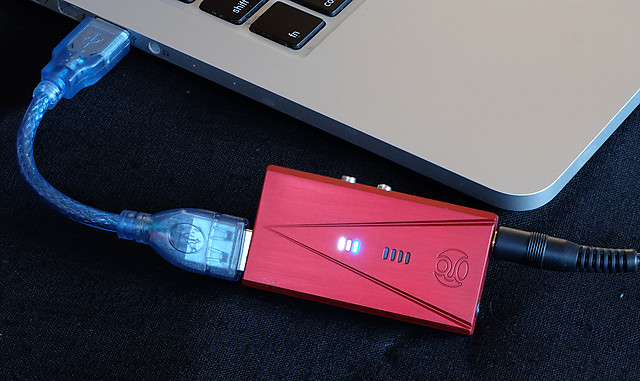
Tiny and light, the Geek Out makes a perfect work or travel companion
The Geek Out 1000 is a featherweight, tipping the scale at a mere 36 grams or 1.27 ounces. The device’s 35mm wide, 78mm long and 13mm thick enclosure is all metal, and for good reason. The two piece, red anodized T6061 aluminum case not only protects the active bits from the rigors of the road, but also acts as a heat sink. The 1000’s amplification stage is “biased into pure class A,” says Gavin, so the little bugger gets quite warm. Part of that stage is monolithic, a dual channel, FET–input OPA1652 operational amplifier from Texas Instruments. With some clever power management, the “GO 1000” outputs 4Vrms into a 16Ω load, a hefty 1 Watt. When asked about power management/conditioning in the 1000, Gavin was cagey: “This is actually our secret sauce. Many people wonder how Larry was about to generate a full watt of amplification power from 5V USB power. We’re not keen to let the world in on that little secret yet.” Larry Ho did mention that, with Geek Out, they “…use current feedback topology in (the) final analog output stage. It sounds much better than a simple voltage buffer output.”
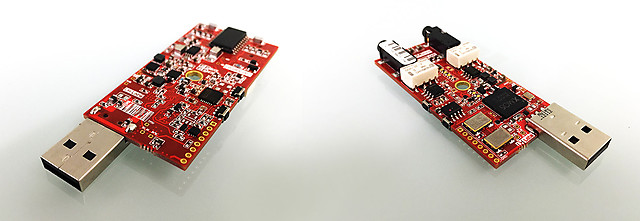
There’s a lot of magic packed into the case
There are two ⅛” output jacks on the small side opposite the USB connector. One is low output impedance, 0.47Ω, and is best for most cans. The other, at 47Ω, serves to drive high impedance headphones, and is also the one to use to feed a preamp, integrated or power amp. Sharing is caring…you can use both outputs at the same time.
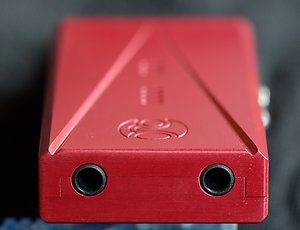
On the top side of the case is two groups of LEDs. One indicates the baseband frequency, 44.1 or 48, and whether you’re decoding DSD data. The other LED set acts as a multiplier indicator: 2x, 4x or 8x. The opposite side of the case has an adhesive cheat sheet in case your long term memory is a bit challenged. There is one other LED, labeled “3D,” which used to indicate that an optional shuffler was in circuit, but that feature was removed to make room for user–selectable filters. Now they have one more LED they can press into service in a future firmware update.
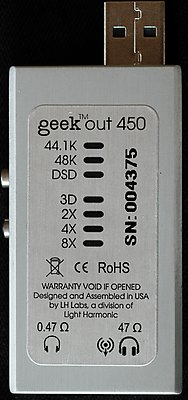
LED decoder chart (the image shows a Geek Out 450)
Two digital anti–imaging filters are on offer, allowing you to trade frequency domain for time domain optimization. One filter mode is called TCM or “Time Coherent Mode,” the other FRM or “Frequency Response Mode.” A convex button on the narrow side of the case selects for TCM and an adjacent concave button sets FRM mode. Regarding TCM, Larry Ho tried to make the time domain behavior the best he could manage with the ESS DAC chip. “We try to make the impulse response as perfect as possible. In theory, NOS (non–over–sampling) will be the best in this field. Da Vinci and (a) few more DACs (also) perform well here…Pre–ring(ing) is one thing that we like to remove, but also minimize the post–ring(ing as well, making)…the sound even more relaxed/smooth.” According to Ho, the other filter mode, FRM, attempts to optimize frequency domain behavior by “…properly setting the roll–off frequency according to the sampling rate, fine (tuning) the pre-ring and post-ring behavior…and also tweak(ing) the FIR/IIR settings in DSD and PCM mode.” In FRM mode, the “…sound will become more ‘accurate’…and sounds nice for some type of music.” The FRM mode provides slightly lower harmonic distortion and noise (THD+N), because the intermodulation distortion (IMD) at higher frequencies is reduced due to high frequency artifact optimization.
When it comes to DACs, I’ll paraphrase Meghan Trainor; “It’s all about the clock, the clock…” Geek Out uses three clocks, technology derived from their premium Da Vinci model. One clocks the XMOS XS1-U8A-64-FB96 USB receiver, another clocks the SABRE ESS9018K2M DAC for audio sampled at multiples of 44.1k, and the third also clocks the DAC chip for audio sampled at multiples of 48kHz. Though I couldn’t get confirmation from LH Labs, I conjecture that the XMOS receiver communicates with the USB 2.0 PHY or “physical layer”, the electrical signaling present on the USB input, and produces output signals that can be conditioned and fed to the Geek Out’s three layer buffer as one clock reference.
The three layer buffer was another technology approach originally developed for the Da Vinci. Ho said that, “…it was designed to ensure that computer speed fluctuations don’t smear your music. This kind of technology is used in high-speed computers, but (we were) the first to employ it in audio. The first layer buffers the source data, the second layer is the decoupling layer, and the third layer is the I2S driver layer.” The devil is in the details of that “decoupling layer,” as that’s where the inevitable mismatch between the average clock speed of the incoming data and the crystal–derived clock running the SABRE must be reconciled.
In use, the 1000 is waaay overpowered for my cans, necessitating a massive amount of negative gain so my head, or headphones, didn’t explode. My LCD-3s require about 30 dB of loss, and most IEMs need more. Transducer sensitivity is the reason why there are three Geek Out models. The 1000 is best driving high impedance, low sensitivity pro cans. Since I don’t have any 600Ω models in the house, I tried my ancient 400Ω AKG K340s. They needed about 20dB of loss.
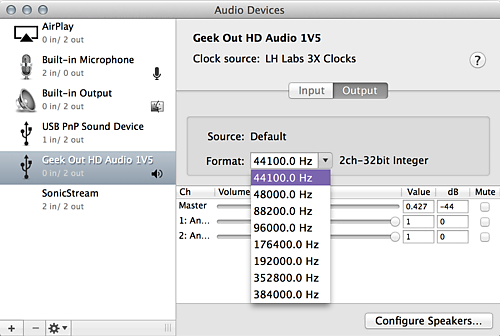
Besides the eye–catching selection of native LPCM sample rates supported, notice the 44 decibels of padding needed for UE900s
LH Labs touts their 64 bit volume control. When asked if it’s double precision floats (floating point, the native numerical representation inside computers) and if it’s purely digital, Gavin provided an overview. “It’s purely digital, but it doesn’t happen inside the DAC. Attenuation happens before the conversion core.” On the subject of floats, Larry Ho offered: “I don’t use float. Float is not bit perfect as you said. What we get from (the) computer is 32 bit integer, then we have (an) internal 64 bit register to map it into 64 bit… Then we start the calculation IF and ONLY IF people set the volume other than 0dB. So (in that case) we will completely skip the WHOLE digital volume calculation and send (the SABRE) bit perfect samples.” When there is digital volume control involved, such as my -44dB example , then they use the “…64 bit register in integer mode and use (the user defined) 32 bit volume settings value we got from (the) computer via USB. Then we do a long multiply into 64 bit space…before we send that sample out to (the) DAC IC, we will dither the result back to 32 bit. Then call it good.”
O.K., back to using the darn thing! A colleague, Wally Malewicz of wamengineering.com, loaned me his AudioQuest Dragonfly (first generation) as we were both curious about comparing the two devices. I tried to make it a fair fight, sticking to 96k and below, mostly 88.2k files. To make switching as easy as possible without compromising sound quality, I used Amarra Hifi, kept both DACs plugged and just dragged the clock selector back and forth in Amarra. The result? I wasn’t surprised.
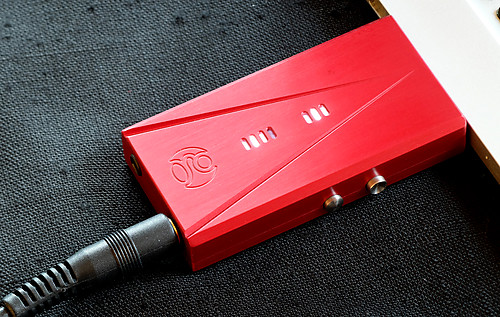
What would you guess? Relatively, one produced a much smaller, narrower overall impression, with a dark, mid–heavy voice and a slightly floppy, weak low frequency response. The mono information was more “there,” while the really stereo stuff, such as hard panned instruments, space and reverb, were suppressed. As to transient response, I noted a “dullness,” and “lack of articulation,” according to my notes. It sounded as though I’d switched from a U-87 to an SM57! Snare snap and the blatt of a trombone in my reference jazz tracks were missing in action.
You probably guessed that was the ’fly…The GO 1000 did everything, er, better; wider, deeper soundstage, far better transient conveyance, solid well proportioned low end. From EDM to banjo noodlings, everything I listened to sounded more real, more involving, less reproduced. You may be thinking, “That isn’t really a fair fight!” and I almost agree. The Dragonfly cost basically half the price but, if the difference between $150 versus $200 for the 450 or $300 for the 1000 is a deciding factor, you’re either new to hi–fi or you’re in the wrong hobby.
For a DAC in this price range, it’s very nice to have a choice of filter topologies. After listening, I found the TCM filter to subtly provide a more filled in soundstage, with a softer, more liquid delivery. The FRM mode filter, with its better time domain response, sounds more precise, more “digital” and clinical though not in a bad way. I found that FRM worked well for me for synthetic material like rock, pop and some jazz, while the TCM mode was all about classical. Unless you have a good set of cans and higher rez material, you might not hear any difference between the filters. That said, pushing those switches is a great way to train your hearing. Speaking of high rez, don’t forget that, with the right software, Geek Out handles DSD and DSD2. That’s mighty handy in those rare instances where you need to play DSD files.
Thinking about the Geek Out 1000 as a stand–alone product, I’d say it’s voiced a tiny bit mid–forward, with good low frequency response plus plenty of detail and dimension. It can drive almost any headphone on the planet, and performs at a higher level than its cost would suggest. If you decide to dig in deep, carefully consider which Geek Out model is right for your preferred cans. Employing less negative gain in use helps to retain the high sound quality of which these little critters are capable. Whether you’re starting out in your HRA adventures, or need a USB DAC that’s as compact and convenient as can be, the Geek Out offers exceptional engineering at a down to earth price. It’s a tiny techno tour de force, and a bargain to boot…highly recommended!
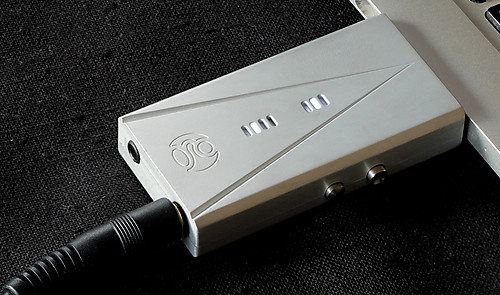
The “little brother” Geek Out 450, which comes in silver
Equipment under review
Geek Out 1000
Manufacturer website: http://www.lhlabs.com/
Product page: http://marketplace.lhlabs.com/products/geek-out-1000-usb-dac-and-headphone-amplifier
Retail price: $299 (USD)
Music in heavy rotation during this review
Olivia Chaney — Oak Ash Thorn (2010 Folk Police via TIDAL) Harkening back to Sandy Denny, Chaney’s clear and present vocals make me wish I was elsewhere.
The Juliana Hatfield Three — Whatever, My Love (2015 American Laundromat) After 21 years, the creators of My Sister is back! Raw, fresh pop/rock from a definitive killer trio. Take a listen to Invisible and If I Could…
Midnight Oil — Blue Sky Mining (1990 Columbia) Still fresh after over two decades, the boys really knew how to craft enduring rock.
Verneri Pohjola — Bullhorn (2015 Edition Records) Finnish trumpeter and composer Pohjola, with his quartet beautifully upholds the tradition of pared down, lyrical and melodic jazz.
Siouxsie & the Banshees — Through the Looking Glass, Peepshow, Superstition, The Rapture (2014 Universal) Grab your eye liner and cuddle up with a quartet of Siouxsie reissues…
ticktock — TCOLT EP (2015 The Big Oil Recording Company) Sebastian Zieler’s fresh, melodic mix is reminiscent of OMD and a bit of Tear For Fears, but really is all his own vision.
Ryan Truesdell — LINES OF COLOR: Gil Evans Project Live at Jazz Standard (2015 Blue Note/ArtistShare) A follow up to Truesdell’s exciting initial release, this well recorded album has six newly discovered, never before recorded works, and a whole bunch more Evans!
Additional gear used for this review
Sources: Amarra Hifi, Audirvana Plus, iTunes
Conversion & pre–amplification: Audioquest Dragonfly, PonoMusic PonoPlayer
Output: Audeze LCD-3, UE 900s, Etymotic ER•4PT, AKG K340




Version 2 of Geek Out arrived about the time I submitted this review for publication so, a quick update is in order:
In addition to other fairly minor enhancements to the original Geek Out family, V2 does away with the 3 models having three different gain structures. This addresses the main complaint I had with the Geek Out 1000; that of gain.
Too much for one set of cans, and just right for another. GO V2 harmonizes the three models, folding them into one…with a gain switch! To quote Gavin, “Geek Out V2 features multiple analog gain settings which solves the problem of deciding which output level will work best for your ever expanding headphone collection. With selectable gain settings of 1000mW, 450mW & 100mW, Geek Out V2 pairs perfectly with those monstrous power hungry cans or your uber sensitive IEM’s.”
For more info on the V2, visit:
http://j.mp/1FZ0E8b